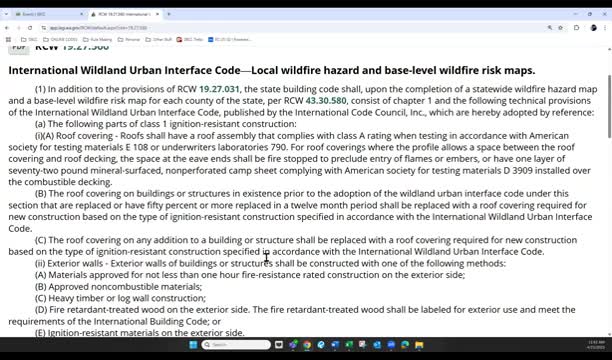Washington Council debates wildfire risk code amid mapping delays and staff constraints
April 27, 2025 | Building Code Council, Governor's Office - Boards & Commissions, Executive, Washington
This article was created by AI summarizing key points discussed. AI makes mistakes, so for full details and context, please refer to the video of the full meeting. Please report any errors so we can fix them. Report an error »

The Building Code Council (SBCC) convened on April 25, 2025, to address critical issues surrounding the implementation of the Wildland-Urban Interface (WUI) code in Washington State. A significant point of discussion was the delay in completing the statewide wildfire hazard maps, which are essential for advancing the WUI code. Council members expressed concerns about the implications of moving forward without these maps, emphasizing the need for a thoughtful and deliberate approach to ensure effective wildfire risk management.
Dustin, a council member, highlighted the urgency of the situation, noting that the current mapping process is behind schedule and is not expected to be completed by the December 1 deadline for the 2024 code. He suggested that advancing the WUI code without the necessary maps could lead to complications and misalignment with legislative requirements. The council is grappling with the challenge of balancing the need for timely action against the risk of implementing ineffective or poorly informed regulations.
Several members voiced their apprehensions about rushing the code development process. Roger pointed out the increasing frequency of wildfires and stressed the importance of establishing a basic level of code adoption to protect communities. However, he acknowledged the staffing challenges faced by the council and the need for a thorough review of the previous code's shortcomings.
Ty and Tom echoed these sentiments, advocating for a cautious approach that prioritizes the quality of the code over speed. They emphasized the importance of incorporating local expertise and ensuring that any new regulations do not undermine existing environmental efforts. The consensus among many council members was that a hasty implementation could lead to more harm than good, particularly in light of past experiences with the WUI code.
Angela clarified that the SBCC currently lacks jurisdiction over the WUI code until the maps are completed, which further complicates the council's ability to take decisive action. She noted that local jurisdictions could adopt their own codes in the interim, but this would require them to conduct their own mapping efforts.
As the meeting concluded, the council recognized the need for ongoing discussions to prepare for the eventual rollout of the WUI code once the maps are available. Members agreed to consider a structured approach to engage with stakeholders and gather input for future legislative proposals aimed at enhancing wildfire safety measures.
The SBCC's deliberations underscore the critical intersection of policy, community safety, and environmental stewardship as Washington State navigates the complexities of wildfire risk management. The council's commitment to a careful and informed process reflects a broader understanding of the challenges posed by climate change and the urgent need for effective building codes that protect both people and the environment.
Dustin, a council member, highlighted the urgency of the situation, noting that the current mapping process is behind schedule and is not expected to be completed by the December 1 deadline for the 2024 code. He suggested that advancing the WUI code without the necessary maps could lead to complications and misalignment with legislative requirements. The council is grappling with the challenge of balancing the need for timely action against the risk of implementing ineffective or poorly informed regulations.
Several members voiced their apprehensions about rushing the code development process. Roger pointed out the increasing frequency of wildfires and stressed the importance of establishing a basic level of code adoption to protect communities. However, he acknowledged the staffing challenges faced by the council and the need for a thorough review of the previous code's shortcomings.
Ty and Tom echoed these sentiments, advocating for a cautious approach that prioritizes the quality of the code over speed. They emphasized the importance of incorporating local expertise and ensuring that any new regulations do not undermine existing environmental efforts. The consensus among many council members was that a hasty implementation could lead to more harm than good, particularly in light of past experiences with the WUI code.
Angela clarified that the SBCC currently lacks jurisdiction over the WUI code until the maps are completed, which further complicates the council's ability to take decisive action. She noted that local jurisdictions could adopt their own codes in the interim, but this would require them to conduct their own mapping efforts.
As the meeting concluded, the council recognized the need for ongoing discussions to prepare for the eventual rollout of the WUI code once the maps are available. Members agreed to consider a structured approach to engage with stakeholders and gather input for future legislative proposals aimed at enhancing wildfire safety measures.
The SBCC's deliberations underscore the critical intersection of policy, community safety, and environmental stewardship as Washington State navigates the complexities of wildfire risk management. The council's commitment to a careful and informed process reflects a broader understanding of the challenges posed by climate change and the urgent need for effective building codes that protect both people and the environment.
View full meeting
This article is based on a recent meeting—watch the full video and explore the complete transcript for deeper insights into the discussion.
View full meeting
